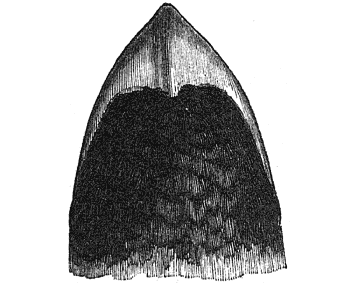Page 04 | prev page next page | ||
Genus CORYDON, Lesson, 1828 Bill very large, much deeper, broader at the base and more booked than that of Eurylaemus, the upper mandible more over-hanging, and with the edge more convex near the gape; but the culmen is comparatively much shorter and more prominent. Rictal bristles replaced by plumules, which are situated in a nude area between the eye and bill. Wings and tail rounded; wing longer than tail. Tarsus distinctly scutellated in front. Sexes alike. The plumage is mostly black, Only a single species is known.
Fig. 4 - head of C. Sumatranus |
| ||
Upper mandible varying from dark reddish brown to pale horny brown, lower mandible pale fleshy-pink with a dark median streak, tips of both whitish; orbital skin and gape dark fleshy-pink; legs, feet, and claws black; irides deep brown. Size: Length 10.5 tail 4.2 wing 5.4 tarsus 1.1 bill from gape 1.6 Distribution: Apparently throughout Tenasserim, except in the deciduous forests, as far north as Karennee; also the Malay Peninsula, Sumatra and Borneo. Habits: This bird is found in pairs or small parties in forests. It is somewhat crepuscular according to Tickell, and during the day very sluggish. It has an oft-repeated mellow, rather musical note; also a clear whistle, which it utters when flying from tree to tree. The nest and eggs do not appear to have been recorded.
Bill not differing much in form from that of Eurylaemus, but narrower, with a somewhat higher culmen, and with the upper mandible straight-edged, not overhanging. The nostrils are elongate, and open in a longitudinal depression a considerable distance from the frontal feathers, about to the length of the bill from the base. Rictal bristles long. Tarsi indistinctly scutellated in front. Coloration above mostly black, below deep crimson. Two species are known, ranging from Arrakan to Borneo.
Key to the Species
Coloration: Upper parts except scapulars, rump, and upper tail-coverts black; chin, upper throat, and a broad pectoral band black; white longitudinal band on each side of the back, formed by outer half of the scapulars; rump, upper tail-coverts, ear-coverts and the throat between them, lower breast, abdomen, flanks, and lower tail-coverts deep crimson, sometimes mixed with orange on the belly; wings black, the edge orange-yellow, under wing-coverts in part, and basal portion of inner web of most wing-feathers white, axillaries yellowish white; tail black, a variable number of the outer feathers with a white sub-terminal spot on the inner web. Young dusky instead of black, white spots on tips of wing coverts, rump mixed red and black; lower plumage dark brown with traces of transverse bars. Upper mandible and a bordering along the edge of the lower mandible brilliant blue, remainder of the latter yellowish, edges of both transparent white; irides emerald-green, shot with gold; legs and feet ultramarine-blue; claws horny (Bingham). Inside of month bright blue (Davison). Size: Length 9.5 tail :3.5 wing 4; tarsus 0.95; bill from gape 1.25. Females rather smaller. Distribution: From Tenasserim through Siam, Cambodia, and the Malay Peninsula to Sumatra and Borneo. This Broadbill was obtained as far north as the Dawna range near Kokarit, east of Moulmein, by Bingham. Habits: Similar to those of Eurylaemus, except that this species, according to Davison, is found in gardens and near villages. It lives entirely on insects. It breeds in Tenasserim from April to June, making the usual large globular Broadbill’s nest of grass, roots, etc. suspended to the end of a bough, and containing 3 or 4 eggs varying from white to salmon-buff in colour, and densely spotted or speckled, especially about the larger end, with black or brownish red. The eggs measure about 1.06 by 0.75.
Coloration: Similar to the last except that the red of the rump is mixed with black; there are always white subterminal spots on all tail-feathers except the middle pair, and these spots become bars on the three outer rectrices on each side; the white at the base of the primaries appears from beneath the outer wing-coverts, and each tertiary has a long red spot at the end. Size: Length 8.2; tail 3; wing 3.6 tarsus 0.86; bill from gape 1.0
Distribution: Arrakan from about lat. 19° southward to Cape Negrais, also the Irrawaddy delta as far east as Rangoon. Nothing is known of the habits. | |||
| prev page :: next page | |||
 birding.in
birding.in
| Birds | Bird Diagram | Ornithology | Indian Sites | Bird Watching | Migration | North India | Birds of India | Haryana |
All rights reserved. Copyright © 2005-2013 Birds and birding in India. Disclaimer
website: Free Java Guide & Tutorials
